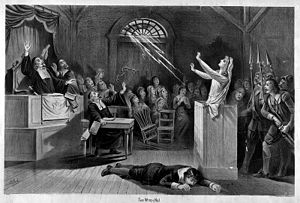The Beginning of The Witch Hunts
The beginning of the witch-hunts as a phenomenon in its own right become apparent during the first half of the 15th century in south-eastern France and western Switzerland.
Here, the cause of eliminating the 'supposed Satanic' witches from society was taken up by a number of individuals; Claude Tholosan for instance had tried over two hundred people accusing them of witchcraft.
Soon, the idea of identifying and prosecuting witches spread throughout the neighboring areas of northern Italy, Switzerland and southern Germany, and a council was assembled. This Church Council, helped to standardize the stereotype of the Satanic witch that would be propagated throughout the rest of the trials.
According to historian Robert Thurston, "From this heart of persecution the witch stereotype spread, both through a flood of new writings on the subject and through men who had been at the Council of Basel and now went elsewhere to take up new assignments in the church."
The most notable of these works was published in 1486 (Info on the book here: Malleus_Maleficarum), in which the stereotypical image of the Satanic witch was set down and torture was prescribed as a means of interrogating suspects. The Malleus Malificarum was reprinted in twenty-nine editions up till 1669.
On December 5, 1484, Pope Innocent VIII gave full papal approval for the inquisition to move against witches, including the permission to do whatever necessary to get rid of them. In the bull, which is sometimes referred to as the "Witch-Bull of 1484", the witches were explicitly accused of having "slain infants yet in the mother's womb" (abortion) and of "hindering men from performing the sexual act and women from conceiving" (contraception).
Trials
There were extensive efforts to root out the supposed influence of Satan by various measures aimed at the people who were accused of being servants of Satan. To a lesser degree, animals were also targeted for prosecution. People suspected of being 'possessed by Satan' were put on trial. On the other hand, the church also attempted to extirpate the superstitious belief in witchcraft and sorcery, considering it as fraud in most cases.
Brutal techniques were routinely used to extract the required admission of guilt from a 'witch'. They included hot pincers, the thumbscrew (A simple vice, which crushed fingers and thumbs), and the "swimming" of suspects (an old superstition whereby innocence was established by immersing the accused in water for a sufficiently long period of time). Besides torture, at trial certain 'proofs' were taken as valid to establish that a person practiced witchcraft.
Execution
The sentence generally was death. Nearly always, a witch's execution involved burning of their body. In England, witches were usually hanged before having their bodies burned and their ashes scattered, though there are several instances where they were burned alive. Most of the victims were never given proper burials, since they had been convicted of witchcraft, they were no longer considered people. They were often laid in unmarked graves. The frequent use of "swimming" to test innocence or guilt means that an unknown number also drowned prior to conviction.





No comments:
Post a Comment